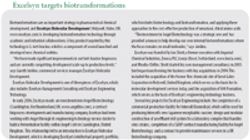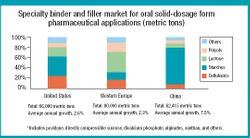Single-Enantiomer Drugs Poised for Further Market Growth
Single-enantiomer drugs account for nearly 40% of the global pharmaceutical market. The author analyzes the current market for single-enantiomer drugs, their role as a generic drug defense strategy, and forecasts for growth.
THE SINGLE-ENANTIOMER drug segment is an important part of the overall pharmaceutical market. Although the therapeutic value of a given medicinal compound is the driving force behind development, a large number of currently marketed drugs and pipeline candidates are chiral, and pharmaceutical companies generally seek to develop these compounds as single enantiomers. Single-enantiomer drugs not only are critical in new drug development, but they also can be used as a defense strategy by innovator drug companies from generic drug competition. By developing racemic switches, or single enantiomers of previously approved racemates, a pharmaceutical company can extend the product's life cycle.These factors provide the market foundation for process research and development teams within pharmaceutical companies and custom manufacturers to continually advance chiral technologies, including catalytic routes in asymmetric synthesis.
Single enantiomers dominate
Single-enantiomer therapeutics had sales of $225 billion in 2005, representing 37% of the total final formulation pharmaceutical market of $602 billion (Table I), based on estimates from Technology Catalysts International (Falls Church, VA) and IMS Health (Plymouth Meeting, PA). The compound annual growth rate for single-enantiomer products over the past five years is 11%, which is on par with the pharmaceutical market as a whole.
Table I: Worldwide sales of single-enantiomer pharmaceutical products final formulation.
Sales growth in several key therapeutic categories has been very robust. Although part of this increase, particularly in cancer therapy, has been from increased approvals for biologics, small-molecule single enantiomers also have played a significant role. The future growth of single-enantiomer products is expected to be strong based on the following key market drivers:
- increased evidence and awareness of improved therapeutic profiles;
- published policies and guidelines of regulatory agencies;
- advances in chiral technologies;
- racemic switches as a generic defense strategy;
- need for new and better anticancer and antiviral drugs.
Key categories for single enantiomers
For the single enantiomer drug market, gastrointestinal (GI), antiviral, respiratory, and cancer therapies are the therapeutic categories exhibiting above-average growth over the past five years.
The racemic switch product "Nexium" (esomeprazole) by AstraZeneca PLC is a major contributor to growth in the GI category (see Figure 1). AstraZeneca first launched the drug in 2000 and reported 2005 sales of $4.6 billion. This product exemplifies the underlying rationale of deciding to forward a racemic switch, namely:
- chemical feasibility of producing a single enantiomer;
- obtaining a clinical advantage;
- obtaining a market advantage.
Figure 1: Esomeprazole, the active pharmaceutical ingredient in AstraZenecaôs Nexium and the (S)-enantiomer of Prilosec (omeprazole), is an example of a successful racemic switch. (US Food and Drug Administration)
The launch of Nexium provided AstraZeneca with a product that offset generic competition that resulted in the decline of sales of the racemate "Prilosec" (omeprazole). In addition, Nexium claims to heal the erosion in the esophagus caused by gastroesophageal reflux disease, thus providing a clinical advantage as well.
Other single enantiomers contributing to growth in the GI segment were "Flomax" or "Harnal" (tamsulosin) and "Remicade" (infliximab). Tamsulosin was developed by Yamanouchi Pharmaceutical, which merged with Fujisawa Pharmaceutical to form Astellas in 2005. Astellas markets the drug with Abbott Laboratories and Boehringer Ingelheim. The compound has patent protection in the United States through 2009, but the patent has been challenged by the Indian pharmaceutical company Ranbaxy Laboratories. Remicade, although originally launched for Crohn's disease, is approved for other indications, including rheumatoid arthritis, which contributed to growth.
Pfizer is developing fesoterodine with Schwarz Pharma for treating urinary incontinence and overactive bladder in response to the expected loss of market exclusivity for Pfizer's "Detrol" (tolterodine) in 2008. Although the patent has not yet expired, court challenges to Pfizer's patent position have occurred. Ranbaxy has tentative approval from the US Food and Drug Administration to market a generic version of tolterodine. Schwarz Pharma submitted a new drug application to FDA and a marketing authorization application to the European Medicines Agency (EMEA). Pfizer has acquired worldwide rights to fesoterdine. Peak sales are expected to be in the range of $650–800 million range, according to industry estimates.
Roche's "Tamiflu" (oseltamivir) is an example of a single enantiomer drug contributing to growth in the antiviral segment. Interest in the product also has led to the development of alternative synthetic routes by researchers at Harvard University (1) and the University of Tokyo (2) to avoid the use of (-)-shikimic or (-)-quinic acids, starting materials in limited supply.
Other single-enantiomer drugs contributing to growth in the antiviral segment include: GlaxoSmithKline's "Valtrex" (valacyclovir), Abbott Laboratories "Kaletra" (lopinavir and ritonavir), GlaxoSmithKline's "Trizivir" (abacavir, zidovudine, and lamivudine), and "Agenerase" (amprenavir).
The recent approval of "Atripla," a once-daily, fixed-dose combination therapy will continue to add to the growth of single-enantiomer sales in the antiviral category. Atripla contains three active pharmaceutical ingredients (APIs): tenofovir, the API in Gilead Sciences's "Viread;" efavirenz, the API in Bristol-Myers Squibb's "Sustiva;"and emtricitabine, the API in "Emtriva." All three drugs are single enantiomers, and the simplified dosing of the combination therapy should enhance patient compliance and, hence, market potential.
Other single-enantiomer drugs recently approved or in development in the antiviral class include "Prezista" (darunavir), a protease inhibitor developed by Johnson & Johnson's Tibotec, and telbivudine, a reverse transcriptase inhibitor under development by Indenix Pharmaceuticals and Novartis.
Darunavir was approved by FDA in June 2006 in combination with a low-dose of ritonavir and other active anti-HIV agents. The compound has shown resistance repellence properties. This means that the compound suppressed the development of new drug-resistant viral strains in addition to inhibiting the replication of existing multidrug strains. The drug has also been submitted to the EMEA for approval in Europe. Peak sales of darunavir are expected in the range of $650–800 million, according to industry estimates.
Telbivudine has been submitted for regulatory approval to FDA and EMEA for treating chronic hepatitis B. Several studies are underway to demonstrate clinical benefits in comparison with Gilead Sciences' "Hepsera" (adefovir dipivoxil). A combination therapy with Idenix Pharmaceuticals' valtorcitabine, another L-nucleoside analog, in Phase II development may be the optimal therapy because of synergies between the two molecules. Peak sales of telbivudine are projected to be between $225–275 million, according to industry estimates.
GlaxoSmithKline's "Advair" (fluticasone and salmeterol) and Merck & Co.'s "Singulair" (montelukast) are two single enantiomers leading growth in the respiratory category. In Advair, GlaxoSmithKline is gaining patients from its older respiratory drugs, including "Serevent"(salmeterol) and "Flixotide" or "Flovent" (fluticasone). GlaxoSmithKline's strategy is to take advantage of the longer patent life for the combination product Advair. The patents for Advair are set to expire in 2010 in the United States and in 2013 in the European Union. The patents for Flixotide or Flovent have expired in both the United States and the European Union. The patents for Serevent are set to expire in 2008 in the United States. In Europe, the only patent protection is in France (2008) and Italy (2009).
Sales increases for cancer therapeutics result from a combination of biologics and small-molecule single enantiomer products. These products include: Genentech's and Roche's "Herceptin" (trastuzumab); "Rituxan" or "MabThera" (rituximab) by Roche, Genentech, and Biogen-Idec; Pfizer's "Camptosar" (irinotecan); Sanofi-Aventis's "Eloxatin" (oxaliplatin), and Eli Lilly's "Gemzar" (gemcitabine).
Pipeline products for cancer therapeutics have focused on biologics, mainly monoclonal antibodies. One example is Amgen's panitumumab, for which peak sales are estimated between $1.3–1.6 billion.
Single enantiomers as blockbusters
The growth in single-enantiomer pharmaceuticals has produced several blockbuster compounds as shown in Table II. As would be expected, many of the high-growth compounds mentioned earlier in this article are included in this list. Others such as Pfizer's "Lipitor" (atorvastatin) and "Zoloft" (sertraline), Amgen's "Epogen" (epoetin alfa), Johnson & Johnson's "Procrit" (epoetin alfa), and Merck & Co.'s "Zocor" (simvastatin) have been among the top selling-drugs for several years. Many of these products are at or nearing the end of their patent life, and innovator drug companies are seeking ways to protect themselves from sales declines from generic competition. For example, Amgen developed "Aranesp" (darbepoetin alfa) as a second generation biologic to Epogen. Aranesp has been so successful that it is also in the top 20 selling drugs.
Table II: Top-selling single enantiomer drugs, global 2005 sales
For Zoloft, Pfizer developed a new synthetic route to lower the cost of manufacture. AstraZeneca responded with the racemic switch from omeprazole to esomeprazole. GlaxoSmithKline targeted a combination product, Advair, to address patent expiries.
It should be noted that many of these blockbusters, specifically 13 pharmaceuticals, are considered small molecules rather than biologics. Thus, continued development of chiral technologies, including catalytic and enzymatic synthesis routes, will be important for contract manufacturers and pharmaceutical companies. Moreover, the development of improved processes will be needed as these compounds come off patent.
Generic competition
The maturing of the single-enantiomer drug market is clearly seen by the arrival of generic competition. The angiotensin-converting enzyme (ACE) inhibitors, the so-called "prils" are the first class of single-enantiomer compounds to face such competition. The following prils have had declining sales in the double-digit range: Pfizer's "Accupril" (quinapril); Novartis' "Lotensin" (benazepril); Bristol-Myers Squibb's "Monopril" (fosinopril); Merck & Co.'s "Vasotec" (enalapril); and AstraZeneca's "Zestril" (lisinopril).
The statins are the next large class of single-enantiomer cardiovascular therapies to see generic competition. Significant generic competition exists for Merck & Co.'s "Mevacor" (lovastatin), and generic competition is increasing for Merck's Zocor (simvastatin), as shown in Table III. Ranbaxy is seeking to launch a generic atorvastatin product, but has lost court cases in the United Kingdom and the United States. Ranbaxy is appealing both cases.
Table III: Potential generic competition of select single enantiomer drugs.
Pfizer developed several combination therapies to protect its position in cholesterol-lowering therapeutics. Caduet, a fixed-dosage formulation combining atorvastatin and amlodipine, was approved in 2004 and treats both hypertension and hypercholesterolaemia. Pfizer reported Caduet sales of $185 million in 2005. In addition, Pfizer is developing its single-enantiomer compounds, atorvastatin (40 mg) and torcetrapib (60 mg) as a fixed-combination therapy for patients with elevated cholesterol, especially LDL-cholesterol, levels, and low HDL-cholesterol levels. Phase III clinical trials are in progress. A new drug application is expected to be filed with FDA in 2007. Peak sales are forecast at $1.3–1.6 billion, based on industry estimates.
Other single-enantiomer, small molecules approved as abbreviated new drug applications or with tentative approvals from FDA are listed in Table III.
Future of single-enantiomer drugs
Overall, single-enantiomer drugs will grow at a similar rate as the pharmaceutical market. Higher growth in key therapeutic categories will be offset by the large and maturing markets in antibiotics and cardiovascular drugs. Part of the higher growth will be from sales increases in biologics, but the use of small molecules in certain key classes such as cancer, arthritis, central nervous system, and antivirals will have significant impact.
Several single-enantiomer drugs introduced in 2005 show ongoing drug innovation. Examples include Amylin Pharmaceuticals' "Byetta" (exanatide), a peptide for improved sugar control in patients with Type II diabetes; Pfizer's "Macugen" (pegaptanib), an aptamer for neovascular age-related macular degeneration; and Sepracor's "Lunesta" (eszoplicone), the (S)-enantiomer of zoplicone for treating insomnia. It will be the push for innovative treatments that will continue to drive the development of single-enantiomer drugs.
Sandra Erb is the manager of chiral and fine chemicals consulting, Technology Catalysts International, 605 Park Avenue, Falls Church, VA 22064, tel. 703.531.0247, fax 703.237.7967, serb@technology-catalysts.com
References
1. Y. Yeung, S. Hong, and E.J. Corey, "A Short Entantioselective Pathway for the Synthesis of the Anti-Influenza Neuramidase Inhibitor Oseltamivir from 1,3-Butadiene and Acrylic Acid," J. Am. Chem. Soc. 128 (9), 6310–6311 (Communication) (2006).
2. M.Shibasaki et al., "De Novo Synthesis of Tamiflu via a Catalytic Asymmetric Ring-Opening of Meso-Aziridines with TMSN3 J. Am. Chem. Soc. 128 (19), 6312–6313 (Communication) (2006).



